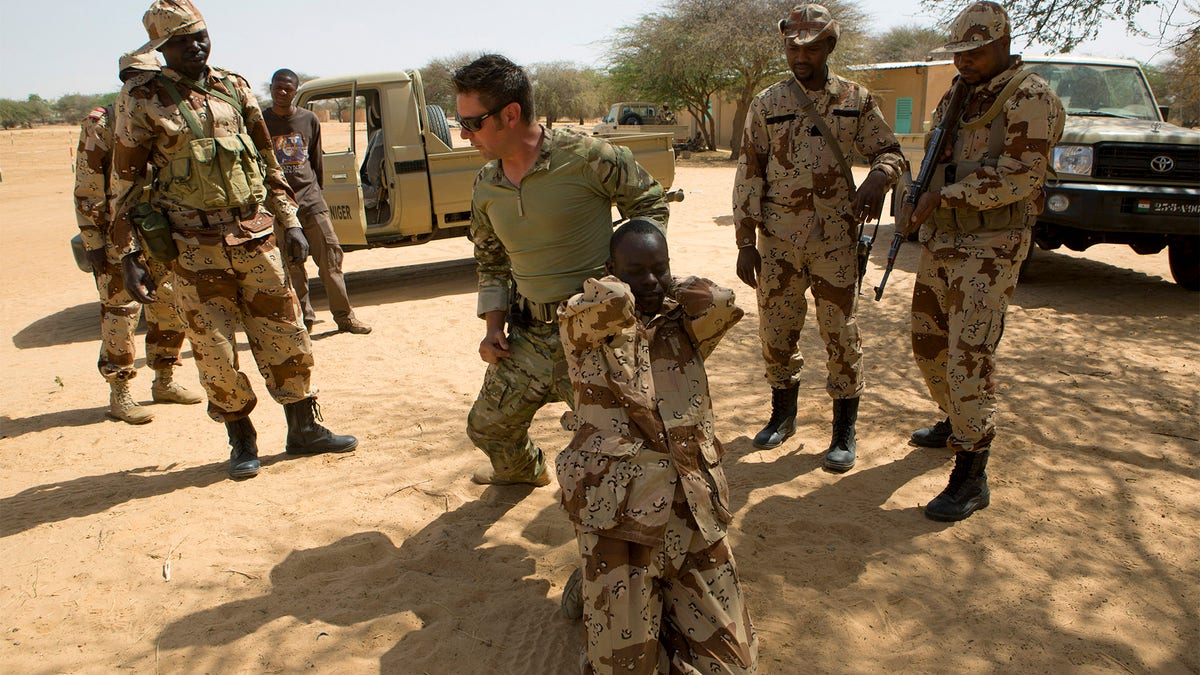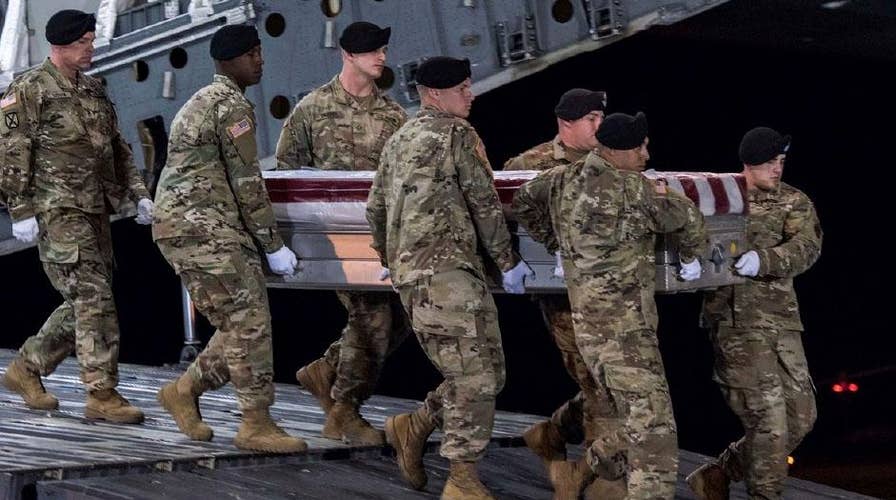Pentagon officials brief lawmakers on Niger attack
Defense officials hold closed-door briefings on deadly ambush that killed four American troops; national security correspondent Jennifer Griffin reports.
The October 4 attack in Niger that claimed the lives of four U.S soldiers – as well as their interpreter and four Nigeriens – remains under official investigation amid a firestorm of controversy and confusion.
While the Pentagon has yet to point explicit blame, the Defense Intelligence Agency suspects the perpretators were ISIS in the Greater Sahel (ISGS) – which references a span of desert from the Red Sea to the Atlantic Ocean and is a group that pledged allegiance to ISIS last year. ISGS is headed by prominent jihadist figure, Adnan Abu Waleed al-Sahrawi.
So who is the apparent chieftain behind the death of the Americans?

Americans killed in Niger on October 4, 2017: Staff Sgt. Bryan Black, Staff Sgt. Jeremiah Johnson, Staff Sgt. Dustin Wright, Sgt. La David Johnson (U.S Army)
“Sahrawi was groomed in al-Qaeda ideology. AQ and ISIS share the goal of establishing an Islamic caliphate,” Steven Cohen, communications director for the Counter Extremism Project – a non-partisan international policy organization that endeavors to combat extremist ideologies – told Fox News. “Sahrawi came out of this anti-Western ideology, which sees the West as the enemy to establishing its caliphate.”
Veryan Khan – the Editorial Director of the Terrorism Research & Analysis Consortium (TRAC) – which has been following Sahrawi’s moves for years said that he was born in 1978 or 79 in Laayoune, a city in the disputed areas of the Western Sahara which is governed by Morocco under UN peacekeeping supervision. Sahrawi, she noted, grew up in the Tindouf camps – an Algerian sprawling commune with military installments – and also studied in the country.
“Sahrawi is a pedigreed jihadist,” Khan said, given that he was a spokesperson for several local jihadist groups with AQ affiliations.
For most of the 21st century, outfits with Al Qaeda (AQ) ties dominated the region, which is also known for its criminal elements and smuggling routes. The main group was known as Al-Murabitoun, helmed by Sahrawi and former one-eyed Algerian AQ commander, Mokhtar Belmokhtar.

Map of Niger. A detail from the World Map. (omersukrugoksu)
Founded in 2013, the AQ-linked group continues to operate in Algeria, southwestern Libya, Mali and Niger with the goal of implementing sharia law, although Sahrawi broke away about two years ago after internal leadership squabbles and developed his own ISIS-aspiring branch, ISGS.
“ISIS in the Greater Sahara (ISGS) primarily operates along the Mali-Niger border in Mali’s Menaka region, but its reach may extend as far as Niamey, Niger,” Samantha Reho, a spokesperson for U.S. Africa Command (AFRICOM) told Fox News.
Multiple intelligence sources told Fox News that the group is relatively small – likely between 100 and 300 members in total. Héni Nsaibia, intelligence analyst at MENASTREAM, a Middle East and North Africa Research & Risk Consultancy, notes that while France and US had given even smaller estimates, between 40-60, their assessment was that the group had grown since to around 100 fighters.

ISGS is predominantly self-funded through kidnapping ransoms, localized robberies and the smuggling of items such as cigarettes and drugs.
“Most of the group’s economic activities appears to be related to illicit trade, hence protecting and taxing smuggling transports and the same for cattle breeders by taxing them in exchange for protection of their herds,” Nsaibia said, adding that there is no clear indication that it receives external funding.

Soldiers in Niger (Reuters)
Furthermore, the extent of its ISIS link is inconclusive.
Last May, Sahrawi officially announced his allegiance to self-designated ISIS “caliph” Abu Bakr al-Baghdadi in 2015, but ISIS never formerly accepted the group’s pledge and never disseminated its news through their propaganda streams. An Arabic Telegram message on October 30, 2016 made loose acknowledgement of the group by ISIS leadership.
And no organization, including ISIS, has claimed responsibility for the deadly October encounter. No pro-ISIS media propaganda channels have lauded the attack, and there has been no effort for ISIS leaders to desperately exploit the attacks on social media as their “caliphate” crumbles in Iraq and Syria.
ISGS has yet to demonstrate the ability to possess heavy weapons or develop vehicle-borne improvised explosive devices, which according to some experts, may be a key reason as to why ISIS is yet to integrate them into the fold as a key state member over fears of appearing “weak.”
“This attack was most likely an independent operation with no ISIS planning or coordination, with Sahwari’s group attacking Nigerien forces and not realizing U.S. forces were embedded,” a U.S military source said.

Americans training soldiers in Niger (Reuters)
“Sahrawi himself most likely didn’t take responsibility, because he doesn’t want the U.S coming after him. But that’s going to happen, regardless.”
Sahrawi and his group have, however, carried out numerous lethal attacks over the past year, including attacks in 2016 on a customs outpost and later a military position in Burkina Faso. The ISIS aspirations demonstrated by Sahrawi and his followers have raised concerns that his outfit could eventually function as a facilitator for ISIS affiliates across West Africa and in Libya and function as a recruitment destination. This would pose a direct threat to the U.S homeland due its global ideology, according to a recent Critical Threats report.
“If ISGS can continue to successfully launch operations, especially on a larger scale, they may be recognized by ISIS leadership,” Khan concurred. “A Saharan branch for ISIS would eventually fill a void. As Islamic State in Libya loses and regains territory in Libya, ISIS may well look for a Saharan arm.”
Nonetheless, AFRICOM’s Reho stated that to-date, they have “no indication the group is planning to target the U.S. homeland and it has not made any public declarations of its intent to target the U.S.”
Nsaibia, too, highlighted that assessments so far do not show any significant threat to the West, but it poses a prominent localized threat to the forces of Niger – a key U.S. counterterrorism partner.
“It is of foremost importance to view ISGS outside the context of the ‘Global War on Terror,’ the group has a hyper-localized agenda. It operates in an environment with strong local dynamics and where conflict is fueled by the usage of pastureland, control of illicit trade routes and so forth,” he said. “We will definitely see more attacks, this is an ongoing conflict and insurgency that shows no signs of subsiding.”
The October attack has put a spotlight on the West African country and this week the U.S. pledged a further $60 million toward helping the region develop a new counterterrorism force. As it stands, there are around 800 U.S troops stationed in Niger and 6000 within 53 countries across the continent.





















